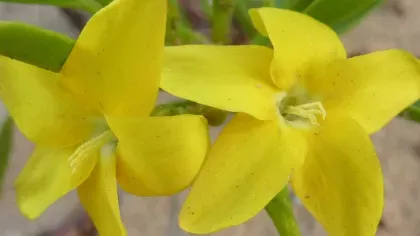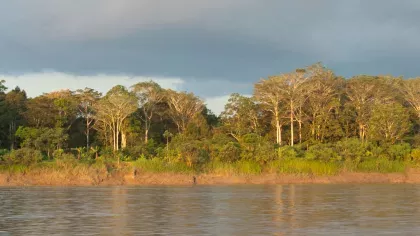10 August 2022
Knowledge for Health
The Ye'kwana people have an exceptional knowledge of medicinal plants that must be preserved.

The Ye’kwana people are an Indigenous group in the Amazon and Orinoco basins that have exceptional knowledge of medicinal plants, but their invaluable expertise is currently at risk.
In Brazil, they live in the Yanomami Territory at the northern edge of the Amazon, where currently there are about 20,000 illegal gold miners (garimpeiros). The impact of this invasion is huge.
Forests have been destroyed and rivers polluted with mercury, in addition to the violence and diseases they have brought with them. This has had a significant impact on their ways of life and security for the Ye’kwana and Yanomami peoples.

Biodiversity protectors
The first Indigenous group I met in the Brazilian Amazon, 35 years ago, were the Ye’kwana people. Meeting them and encountering their remarkable knowledge of the plants and animals around them profoundly altered my career.
The Indigenous Peoples in the Amazon, and elsewhere in the world, are crucial custodians of biodiversity, protecting the environment and building resilience to natural disasters or climate change. Their accumulated knowledge, passed down from one generation to the next, is essential for their survival and culture, as well as for science.
As a result, I began focusing on recording traditional knowledge around the world, including in Amazonia. Some of the projects I have worked on have focussed on sustainable use, conservation and transmission of dangerous diseases such as malaria.


Recording traditional knowledge
In the early 1990s, as part of a wider project recording antimalarials, I visited two of the Ye’kwana communities. Several plant species were traditionally used for treating malaria, but I recorded many others that are used by the Ye’kwana to treat different diseases.
Most of these data were never published, due to concerns regarding intellectual property rights. The information has been sitting on my computer in Kew for almost 30 years and I had often wondered if that knowledge still exists, and if it is now threatened.
“Now our children know almost nothing, they do not know how to find medicines in the forest. In the past we used to teach our children and grandchildren about the medicines. We need to know what we have in the woods… There are specific remedies in the forest, we need to know so we can help our children, our grandchildren, to prolong our lives, our survival.”
Majaanuma (Ye’kwana), 2016. From: The Ye’kwana cosmosonics: a musical ethnography of a north-amazon people.


Over the last four years I have been revisiting this work. Collaborating with Seduume (the Ye’kwana association), Instituto Socioambiental (a Brazilian NGO) and the anthropologist Majoí Gongora, we flew to the Auaris community in 2019. The aim of this visit was to train three Indigenous researchers, and to have a wider discussion amongst the communities about how to record it and, ultimately, pass it back in a useful format before it disappears.
Medicinal information was primarily held by the older members of the Ye’kwana communities, known as the ‘sábios’, and this knowledge was not being passed down to younger generations. This is partly due to cultural change, including young people going to the city for education.
Although we provided guidance including ethnobotanical training, it was up to the Ye’kwana to make their own decisions. They decided not to send plant samples outside their communities, but to photograph them for identification. Their data will only be made available in the Ye’kwana language, to avoid their traditional knowledge being made available to others. The data they collect will not be published in academic journals, but will remain within their own communities, including within educational resources.
So far, over 270 medicinal species have been identified, including a few insects and spiders. This month, there will be a meeting in one of the communities to discuss all the information collected so far and, if necessary, correct it or add additional species from the participants. Furthermore, young Ye’kwana people will take more images of the plants, based on training by a Brazilian photographer.
A novel approach
This project is a novel initiative, which empowers the knowledge holders and supports Indigenous health and traditional culture.
In terms of the academic outcomes, this will be the development of an innovative approach that could be used or adapted more broadly elsewhere. In terms of the outcomes for the Ye’kwana, this involves a revival of traditional medicinal knowledge for future generations, and improved scientific collaboration and informed decision-making.
Assisting Indigenous research will help redress the historical imbalance between science and local knowledge.
References
Milliken, W. (1997). Traditional anti-malarial medicine in Roraima, Brazil. Economic Botany, 51: 212-237.
Turner, N. J., Cuerrier, A., & Joseph, L. (2022). Well grounded: Indigenous Peoples' knowledge, ethnobiology and sustainability. People and Nature.
Wheeler, H. C. & Root‐Bernstein, M. (2020). Informing decision‐making with Indigenous and local knowledge and science. Journal of Applied Ecology, 57: 1634-1643.
De Castro Albernaz, P. (2020). The Ye’kwana cosmosonics: a musical ethnography of a north-amazon people. Universität Tübingen.
Yanomami, M., Yanomami, E., Albert, B., Milliken, W. & Coelho, V. (2015). Manual dos remédios tradicionais Yanomami. Hutukara Associação Yanomami, Boa Vista.



